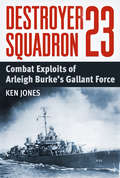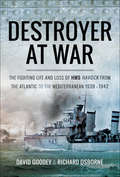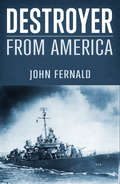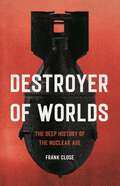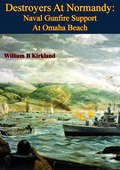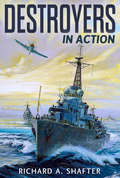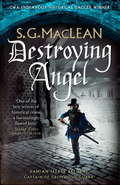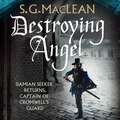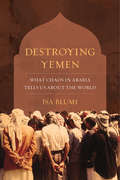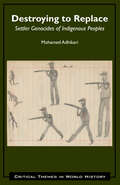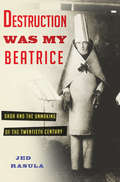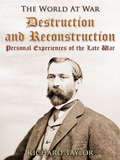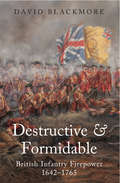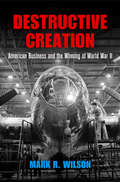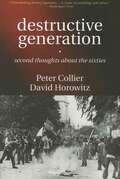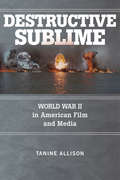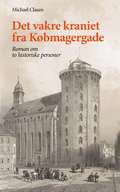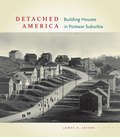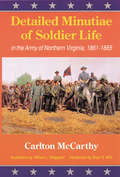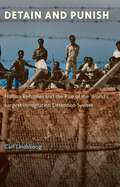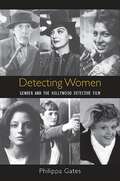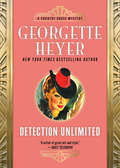- Table View
- List View
Destroyer Squadron 23: Combat Exploits of Arleigh Burke's Gallant Force
by John Kenneth JonesDestroyer Squadron 23, first published in 1959, is the epic account of Commodore Arleigh Burke and the men and ships under his command in the South Pacific in World War II. Burke’s leadership skills and innovative tactics, described in detail in the book, proved crucial to the U.S. defeat of the Japanese navy in the Pacific. Included are 10 pages of maps.
Destroyer at War: The Fighting Life and Loss of HMS Havock from the Atlantic to the Mediterranean 1939–42
by Richard Osborne David GoodeyIt was headline news on 8 April 1942: One of the Navys most famous destroyers, a ship which survived bombs, torpedoes and full scale battles, has been wrecked. That destroyer was HMS Havock, described in another newspaper as Britains No 2 Destroyer of this war second only in fame and glory to the Cossack.Havock had earned her reputation guarding the convoys across the Atlantic in 1939 and at Narvik in the abortive bid to stave off the German occupation of Norway in 1940. Havock was then transferred to the Mediterranean, fighting at the Battle of Cape Spada in 1940 and in 1941 at the Battle of Matapan and in the evacuations of Greece and Crete.Havocks duties in the Med continued, escorting the convoys to the besieged island of Malta and the equally beleaguered garrison at Tobruk. Then in the Battle of Sirte in 1942 Havock was badly damaged and she limped into Malta for repairs. There she was heavy bombed and when Havock made a bid to reach Gibraltar, she was wrecked off Cape Bon. Her crew was captured and imprisoned in the infamous Laghouat internment camp.The authors have tracked down fifty of the surviving crew and from interviews have been able to compile one of the most detailed, and certainly one of the most dramatic, histories of a destroyer during the Second World War. Destroyer at War tells the story of the battles and operations of a famous ship, and its sad destruction, through newspaper reports, official documents, and the words of the men who sailed and fought in HMS Havock as she earned an astonishing eleven battle honors in her brief but glorious career.
Destroyer from America
by John B. FernaldDestroyer from America, first published in 1942, is a fictionalized account of life aboard a naval destroyer on convoy duty in the North Atlantic during the early days of World War II. Although not filled with combat scenes, the book paints an accurate picture of life aboard a destroyer as the men deal with the inclement weather, lost ships, boredom, missed loved ones, and an encounter with a German submarine. Author John B. Fernald served in the Royal Navy Volunteer Reserve during the war, aboard the HMS Newmarket, formerly the USS Robinson of the U.S. Navy, one of the four-stacker destroyers provided to the British before America's entry into the war.
Destroyer of Worlds: The Deep History of the Nuclear Age
by Frank CloseThe thrilling and terrifying seventy-year story—"kinetic, dramatic, and compulsively readable" (Patchen Barss)—of the physicists that deciphered the atom and created the hydrogen bomb Although Henri Becquerel didn&’t know it at the time, he changed history in 1896 when he left photographic plates and some uranium rocks in a drawer. The rocks emitted something that exposed the plates: it was the first documented evidence of spontaneous radioactivity. So began one of the most exciting and consequential efforts humans have ever undertaken. As Frank Close recounts in Destroyer of Worlds, scientists confronting Becquerel&’s discovery had three questions: What was this phenomenon? Could it be a source of unlimited power? And (alas), could it be a weapon? Answering them was an epic journey of discovery, with Ernest Rutherford, Enrico Fermi, Irene Joliot-Curie, and many others jockeying to decipher the dance of particles in a decaying atom. And it was a terrifying journey as well, as Edward Teller and others pressed on from creating atom bombs to hydrogen bombs so powerful that they could destroy all life on earth. The deep history of the nuclear age has never before been recounted so vividly. Centered on an extraordinary cast of characters, Destroyer of Worlds charts the course of nuclear physics from simple curiosity to potential Armageddon.
Destroyers At Normandy: Naval Gunfire Support At Omaha Beach [Illustrated Edition]
by William B. Kirkland John C. ReillyIncludes numerous maps and illustrations.This monograph provides first-hand accounts of Destroyer Squadron 18 during this critical battle upon which so much of the success of our campaign in Europe would depend. Their experience at Omaha Beach can be looked upon as typical of most U.S. warships engaged at Normandy. On the other hand, from the author's research it appears evident that this destroyer squadron, with their British counterparts, may have had a more pivotal influence on the breakout from the beachhead and the success of the subsequent campaign than was heretofore realized. Its contributions certainly provide a basis for discussion among veterans and research by historians, as well as a solid, professional account of naval action in support of the Normandy landings.
Destroyers in Action
by Richard A. ShafterDestroyers in Action, first published in 1945 as part of The U.S. Navy in Action Series, examines some of the important battles waged by the U.S. Navy destroyer fleet (especially those of World War II), and the stories of notable ships such as the Laffy, O'Bannon, Ward, and Prairie. Also included are profiles of the ships' officers and crews and legendary commanders, strategies and tactics used against the enemy, and historic naval conflicts. Author Richard Shafter served as an officer aboard a destroyer in WWII. Included are 11 pages of illustrations.
Destroying Angel: Winner of the 2019 CWA Historical Dagger (The Seeker #3)
by S.G. MacLeanWINNER OF THE 2019 CWA HISTORICAL DAGGER'A gripping tale of crime and sedition' Sunday Times on The Black Friar'The best historical crime novel of the year' Sunday Express on The SeekerCaptain Damian Seeker has gone north. Charged with preparing the way for the rule of the major-generals, he is now under the command of Colonel Robert Lilburne at York. But when Lilburne orders him to a small village on the North York moors with details of the stringent new anti-Royalist laws, Seeker finds that what should be a routine visit will reveal a plot to rival anything in scheming LondonAn invitation to dinner at the house of local businessman Matthew Pullan lifts the lid on the bubbling cauldron of grudges and resentment that is Faithly village. The local constable, drunk on the tiny bit of power he holds, using it to avenge old resentments. The hated lord of the manor, the last of a staunchly Royalist family who has managed to avoid suspicion of treachery - for now. The vicar on trial for his job and his home, accused of ungodly acts. And the Pullans themselves, proudly Puritan but disillusioned with Cromwell's government, respected and despised in Faithly in equal measure. The man for whom this unlikely gathering was organised - The Trier, the enforcer of Puritan morality for the local villages - hasn't shown up. And by the end of the night, on of those gathered around Matthew Pullan's table will be fatally poisoned.Seeker must find out the motive behind the death - mushroom misidentification, petty revenge, or part of a larger plot against Cromwell's government in the north? But who in Faithly, if anyone, can he trust? And when the most painful part of his past reappears after eleven years, will the Seeker meet his match?
Destroying Angel: Winner of the 2019 CWA Historical Dagger (The Seeker #3)
by S.G. MacLeanWINNER OF THE 2019 CWA HISTORICAL DAGGER'A gripping tale of crime and sedition' Sunday Times on The Black Friar'The best historical crime novel of the year' Sunday Express on The SeekerCaptain Damian Seeker has gone north. Charged with preparing the way for the rule of the major-generals, he is now under the command of Colonel Robert Lilburne at York. But when Lilburne orders him to a small village on the North York moors with details of the stringent new anti-Royalist laws, Seeker finds that what should be a routine visit will reveal a plot to rival anything in scheming LondonAn invitation to dinner at the house of local businessman Matthew Pullan lifts the lid on the bubbling cauldron of grudges and resentment that is Faithly village. The local constable, drunk on the tiny bit of power he holds, using it to avenge old resentments. The hated lord of the manor, the last of a staunchly Royalist family who has managed to avoid suspicion of treachery - for now. The vicar on trial for his job and his home, accused of ungodly acts. And the Pullans themselves, proudly Puritan but disillusioned with Cromwell's government, respected and despised in Faithly in equal measure. The man for whom this unlikely gathering was organised - The Trier, the enforcer of Puritan morality for the local villages - hasn't shown up. And by the end of the night, on of those gathered around Matthew Pullan's table will be fatally poisoned.Seeker must find out the motive behind the death - mushroom misidentification, petty revenge, or part of a larger plot against Cromwell's government in the north? But who in Faithly, if anyone, can he trust? And when the most painful part of his past reappears after eleven years, will the Seeker meet his match?
Destroying Angel: Winner of the 2019 CWA Historical Dagger (The Seeker)
by S.G. MacLeanWINNER OF THE 2019 CWA HISTORICAL DAGGER'A gripping tale of crime and sedition' Sunday Times on The Black Friar'The best historical crime novel of the year' Sunday Express on The SeekerCaptain Damian Seeker has gone north. Charged with preparing the way for the rule of the major-generals, he is now under the command of Colonel Robert Lilburne at York. But when Lilburne orders him to a small village on the North York moors with details of the stringent new anti-Royalist laws, Seeker finds that what should be a routine visit will reveal a plot to rival anything in scheming LondonAn invitation to dinner at the house of local businessman Matthew Pullan lifts the lid on the bubbling cauldron of grudges and resentment that is Faithly village. The local constable, drunk on the tiny bit of power he holds, using it to avenge old resentments. The hated lord of the manor, the last of a staunchly Royalist family who has managed to avoid suspicion of treachery - for now. The vicar on trial for his job and his home, accused of ungodly acts. And the Pullans themselves, proudly Puritan but disillusioned with Cromwell's government, respected and despised in Faithly in equal measure. The man for whom this unlikely gathering was organised - The Trier, the enforcer of Puritan morality for the local villages - hasn't shown up. And by the end of the night, on of those gathered around Matthew Pullan's table will be fatally poisoned.Seeker must find out the motive behind the death - mushroom misidentification, petty revenge, or part of a larger plot against Cromwell's government in the north? But who in Faithly, if anyone, can he trust? And when the most painful part of his past reappears after eleven years, will the Seeker meet his match?
Destroying Yemen: What Chaos in Arabia Tells Us about the World
by Isa BlumiSince March 2015, a Saudi-led international coalition of forces—supported by Britain and the United States—has waged devastating war in Yemen. Largely ignored by the world’s media, the resulting humanitarian disaster and full-scale famine threatens millions. Destroying Yemen offers the first in-depth historical account of the transnational origins of this war, placing it in the illuminating context of Yemen’s relationship with major powers since the Cold War. Bringing new sources and a deep understanding to bear on Yemen’s profound, unwitting implication in international affairs, this explosive book ultimately tells an even larger story of today’s political economy of global capitalism, development, and the war on terror as disparate actors intersect in Arabia.
Destroying to Replace: Settler Genocides of Indigenous Peoples (Critical Themes in World History)
by Mohamed Adhikari"This book explores settler colonial genocides in a global perspective and over the long durée. It does so systematically and compellingly, as it investigates how settler colonial expansion at times created conditions for genocidal violence, and the ways in which genocide was at times perpetrated on settler colonial frontiers. This volume will prove invaluable to teachers and students of imperialism, colonialism, and human rights."—Lorenzo Veracini, Swinburne University of Technology, and author of The World Turned Inside Out: Settler Colonialism as a Political Idea
Destruction Was My Beatrice: Dada and the Unmaking of the Twentieth Century
by Jed RasulaIn 1916, as World War I raged around them, a group of bohemians gathered at a small nightclub in Zurich, Switzerland for a series of bizarre performances. Three readers simultaneously recited a poem in three languages; a monocle-wearing teenager performed a spell from New Zealand; another young man flung bits of papier-mâché into the air and glued them into place where they landed. One of these artists called the sessions "both buffoonery and a requiem mass. ” Soon they would be known by a more evocative name: Dada. In Destruction Was My Beatrice, modernist scholar Jed Rasula presents the first narrative history of the emergence, decline, and legacy of Dada, showing how this strange artistic phenomenon spread across Europe and then the world in the wake of the Great War, fundamentally reshaping modern culture in ways we’re still struggling to understand today.
Destruction and Reconstruction: Personal Experiences Of The Late War (The World At War)
by Richard TaylorIn this unique series, the Civil War comes vividly to life, as those who were there give eye-witness accounts from both sides of the bloody conflict. A sugar farmer and gentleman politician with no military training before the war, General Richard Taylor--son of President Zachary Taylor--plays a major role in the Red River campaign. Out of print since 1879. (Excerpt from Goodreads)
Destructive & Formidable: British Infantry Firepower, 1642–1756
by David Blackmore&“Looks at British infantry doctrine . . . from the British Civil Wars of the seventeenth century up to just before the American War of Independence.&” —British Civil Wars Blog In the seventeenth and eighteenth centuries, the British Army&’s victories over the French at battles such as Blenheim in 1704, Minden and Quebec in 1759, and over the Jacobites at Culloden in 1746, were largely credited to its infantry&’s particularly effective and deadly firepower. For the first time, David Blackmore has gone back to original drill manuals and other contemporary sources to discover the reasons behind this. This book employs an approach that starts by considering the procedures and practices of soldiers in a given period and analyzes those in order to understand how things were done and, in turn, why events unfolded as they did. In doing so, Blackmore has discovered a specifically British set of tactics, which created this effectiveness and allowed it to be maintained over such a long period, correcting many of the misconceptions about British infantry firepower in the age of the musket and linear warfare in a major new contribution to our understanding of an important period of British military history. &“Essential reading for anyone interested in the British army of the 17th and 18th centuries.&”—Military History Monthly
Destructive Creation: American Business and the Winning of World War II
by Mark R. WilsonDuring World War II, the United States helped vanquish the Axis powers by converting its enormous economic capacities into military might. Producing nearly two-thirds of all the munitions used by Allied forces, American industry became what President Franklin D. Roosevelt called "the arsenal of democracy." Crucial in this effort were business leaders. Some of these captains of industry went to Washington to coordinate the mobilization, while others led their companies to churn out weapons. In this way, the private sector won the war--or so the story goes.Based on new research in business and military archives, Destructive Creation shows that the enormous mobilization effort relied not only on the capacities of private companies but also on massive public investment and robust government regulation. This public-private partnership involved plenty of government-business cooperation, but it also generated antagonism in the American business community that had lasting repercussions for American politics. Many business leaders, still engaged in political battles against the New Deal, regarded the wartime government as an overreaching regulator and a threatening rival. In response, they mounted an aggressive campaign that touted the achievements of for-profit firms while dismissing the value of public-sector contributions. This probusiness story about mobilization was a political success, not just during the war, but afterward, as it shaped reconversion policy and the transformation of the American military-industrial complex.Offering a groundbreaking account of the inner workings of the "arsenal of democracy," Destructive Creation also suggests how the struggle to define its heroes and villains has continued to shape economic and political development to the present day.
Destructive Generation: Second Thoughts About the Sixties
by Peter Collier David HorowitzAs leading New Leftists in the Sixties, Peter Collier and David Horowitz were intimately involved in the radicalism of the day. Later on, they became the first of their generation to publicly reject the objectives of that revolutionary era and point out the cultural chaos it had left behind. <p><p>Part memoir, part political analysis, part social history, DESTRUCTIVE GENERATION is the compelling story of their intellectual journey into and out of the radical trenches. Telling stories of the New Left's most famous (and infamous) personalities and events, Collier and Horowitz reveal the destructive legacy of the Sixties and the way in which that decade continues to cast a long shadow over politics and culture today. <p><p>When it was first published more than a decade ago, DESTRUCTIVE GENERATION was a controversial bestseller that some critics compared to Whittaker Chambers' powerful political testament, WITNESS. This new edition contains new material which makes this classic work more relevant than ever in our own divided time.
Destructive Sublime: World War II in American Film and Media (War Culture)
by Tanine AllisonThe American popular imagination has long portrayed World War II as the “good war,” fought by the “greatest generation” for the sake of freedom and democracy. Yet, combat films and other war media complicate this conventional view by indulging in explosive displays of spectacular violence. Combat sequences, Tanine Allison argues, construct a counter-narrative of World War II by reminding viewers of the war’s harsh brutality.Destructive Sublime traces a new aesthetic history of the World War II combat genre by looking back at it through the lens of contemporary video games like Call of Duty. Allison locates some of video games’ glorification of violence, disruptive audiovisual style, and bodily sensation in even the most canonical and seemingly conservative films of the genre. In a series of case studies spanning more than seventy years—from wartime documentaries like The Battle of San Pietro to fictional reenactments like The Longest Day and Saving Private Ryan to combat video games like Medal of Honor—this book reveals how the genre’s aesthetic forms reflect (and influence) how American culture conceives of war, nation, and representation itself.
Det vakre kraniet fra Købmagergade: Roman om to historiske personer
by Michael ClasenKøbenhavn 1825 i den såkalte danske gylne tid. Carl Otto er lege, og leder av sykehuset ved det danske statsfengselet i Købnhavn. Han er vitenskapsmann, mmen mener at en kan finne ut omtrent alt om et menneskes evner og karakter ved måling av kraniet. Han er - med andre ord - landets ledende talsmann for såkalt vitenskapelig frenologi. Vitenskapelig tar han selvfølgelig feil, og dette blir han motvillig klar over når han får en ny pasient i sykehuset: En fattig, fordrukken, løgnaktig og tyvaktig bondekone som har blitt benådet fra dødsdom. Det spesielle møtet mellom to personer fra diamtralt motsatte samfunnsforhold truer med å knuse Carl Ottos anseelse og sosiale posisjon og fører ham inn i en dyp samvittighetskonflikt. Romanen består av Carl Ottos nedtegnelser, alternerende med historier fra den fattige, kriminelle kvinnens liv fra barndom til hennes død i fengselet. Hele den historiske beretningen innrammes av et moderne narrativ som forklarer hvordan Ottos papirer er blitt oppdaget. Både Carl Otto og hans motstykke Anne Andersdatter er virkelige, historiske personer, og nesten alt i romanen erbasert på research og faktiske hendelser.
Detached America: Building Houses in Postwar Suburbia (Midcentury: Architecture, Landscape, Urbanism, and Design)
by James A. JacobsDuring the quarter century between 1945 and 1970, Americans crafted a new manner of living that shaped and reshaped how residential builders designed and marketed millions of detached single-family suburban houses. The modest two- and three-bedroom houses built immediately following the war gave way to larger and more sophisticated houses shaped by casual living, which stressed a family's easy sociability and material comfort and were a major element in the cohesion of a greatly expanded middle class. These dwellings became the basic building blocks of explosive suburban growth during the postwar period, luring families to the metropolitan periphery from both crowded urban centers and the rural hinterlands. Detached America is the first book with a national scope to explore the design and marketing of postwar houses. James A. Jacobs shows how these houses physically document national trends in domestic space and record a remarkably uniform spatial evolution that can be traced throughout the country. Favorable government policies, along with such widely available print media as trade journals, home design magazines, and newspapers, permitted builders to establish a strong national presence and to make a more standardized product available to prospective buyers everywhere. This vast and long-lived collaboration between government and business--fueled by millions of homeowners--established the financial mechanisms, consumer framework, domestic ideologies, and architectural precedents that permanently altered the geographic and demographic landscape of the nation.
Detailed Minutiae of Soldier Life in the Army of Northern Virginia, 1861-1865
by Eugene McCarthy Brian S. WillsThis Civil War classic of soldiering in the ranks debunks all the romantic notions of war. Like his Northern counterpart, the Confederate soldier fought against bullets, starvation, miserable weather, disease, and mental strain. But the experience was perhaps even worse for Johnny Reb because of the odds against him. Never as well equipped and provisioned as the Yankee, he nevertheless performed heroically. Carlton McCarthy, a private in the Army of Northern Virginia, describes the not-always-regular rations, various improvisations in clothing and weaponry, campfire entertainments, the jaunty spirits and the endless maneuvering of the men in gray. Real but forgotten faces are glimpsed momentarily in famous battles, and the tramp of feet on the way to Appomattox is heard. Detailed Minutiae of Soldier Life does for the Confederate side what John Billings’s Hardtack and Coffee, also a Bison Book, does for the Northern. David Donald wrote in the New York Herald Tribune that McCarthy’s book, too, was "as fresh, as amusing, and as revealing" as the day it was first published in 1882. In a new introduction Brian S. Wills considers the book’s niche in Civil War literature.
Detain and Punish: Haitian Refugees and the Rise of the World's Largest Immigration Detention System
by Carl LindskoogHonorable Mention, Latin American Studies Association Haiti-Dominican Republic Section Isis Duarte Book Prize Immigrants make up the largest proportion of federal prisoners in the United States, incarcerated in a vast network of more than two hundred detention facilities. This book investigates when detention became a centerpiece of U.S. immigration policy, revealing why the practice was reinstituted in 1981 after being halted for several decades and how the system expanded to become the world’s largest immigration detention regime. From the Krome Detention Center in Miami to Guantanamo Bay, Cuba, and to jails and prisons across the country, Haitians have been at the center of the story of immigration detention. When an influx of Haitian migrants and asylum seekers came to the U.S. in the 1970s, the government responded with exclusionary policies and detention, setting a precedent for future waves of immigrants. Carl Lindskoog details the discrimination Haitian refugees faced and how their resistance to this treatment—in the form of legal action and activism—prompted the government to reinforce its detention program and create an even larger system of facilities. Drawing on extensive archival research, including government documents, advocacy group archives, and periodicals, Lindskoog provides the first in-depth history of Haitians and immigration detention in the United States. Lindskoog asserts that systems designed for Haitian refugees laid the groundwork for the way immigrants to America are treated today. Detain and Punish provides essential historical context for the challenges faced by today’s immigrant groups, which are some of the most critical issues of our time.
Detainee Abuse During Op TELIC: 'a Few Rotten Apples'?
by Timothy WoodThis book reviews the nature of the alleged abuse committed by the UK military forces, exploring the legal paradigm in which the abuse allegedly occurred; the morality of those accused; and the robustness of the accusation of a 'policy of abuse'.
Detecting Women: Gender and the Hollywood Detective Film
by Philippa GatesFinalist for the 2012 Edgar Award in the Best Critical/Biographical Category presented by the Mystery Writers of AmericaIn this extensive and authoritative study of over 300 films, Philippa Gates explores the "woman detective" figure from her pre-cinematic origins in nineteenth century detective fiction through her many incarnations throughout the history of Hollywood cinema. Through the lens of theories of gender, genre, and stardom and engaging with the critical concepts of performativity, masquerade, and feminism, Detecting Women analyzes constructions of the female investigator in the detective genre and focuses on the evolution of her representation from 1929 to today. While a popular assumption is that images of women have become increasingly positive over this period, Gates argues that the most progressive and feminist models of the female detective exist in mainstream film's more peripheral products such as 1930's B-picture and 1970's Blaxploitation films. Offering revisions and new insights into peripheral forms of mainstream film, Gates explores this space that allows a fantasy of resolution of social anxieties about crime and, more interestingly, gender, in the 20th and early 21st centuries. The author's innovative, engaging, and capacious approach to this important figure within feminist film history breaks new ground in the field of gender and film studies.
Detection Unlimited (Country House Mysteries #12)
by Georgette Heyer"Miss Heyer's characters and dialogue are an abiding delight to me... I have seldom met people to whom I have taken so violent a fancy from the word 'Go'."—Dorothy L. SayersSlumped on a seat under an oak tree is old Sampson Warrenby, with a bullet through his head.Everybody in the village is ready to tell Chief Inspector Hemingway who did it. Could the murderer have been the dead man's niece? Or perhaps it was the other town solicitor? The couple at the farm had a guilty secret-what was it? And why is it someone else actually wants to be the prime suspect?Add to this the fact that Warrenby was blackmailing someone, and Hemingway has his work cut out for him."Georgette Heyer is second to none in her ability to make detective stories entertaining."—Sunday Times
